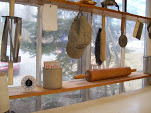A friend gave me a copy of "The Paul Richards Pastry Book", dated 1907. It has over one thousand recipes between the covers, one of the best of which, for mincemeat, calls for finished mince to be aged in an oaken barrel for at least month. A cooperage in Arkansas custom made a sturdy oak wine cask for me, which I use to mellow that ambrosial mix every October in readiness for Thanksgiving.
A recipe with the name "floradora buns" caught my eye. Essentially small oval buns made of sweet dough, coconut, vanilla, and candied orange and lemon peels, baked with almonds sprinkled over their tops, then washed with vanilla glaze directly from the oven. The aroma is a delight, as must have been the namesake of these little beauties for Mr. Richards. The "Floradora Girls" were a dancing troupe of English women who came to the States at the turn of the twentieth century. One can only guess at the effect they had on old Paul, but recipes for floradora pie, floradora pudding, floradora cake and the like, give one an idea. Him too, no doubt.
Another interesting formula was this one:
MAIDEN YEAST
Take a two handfuls of hops and boil in two quarts of water for half an hour; strain off the hops and put the liquor in a strong bottle with a two handfuls of malt and a little sugar; cork up and tie securely with wire, and let it stand in a warm place for forty-eight hours. Then it will be ready to start stock with.
Take five ounces of hops, two pounds of malt, three and one-half pounds of flour, five gallons of water, two quarts of stock yeast [ above ]. Boil the hops and water for one hour; Strain and scald the flour with part of the water into a smooth paste. Cool the hop water to 165 deg. fahr.; add the malt and let mash and cool down to 85 degrees, about blood warm. Strain and wash off the malt; add the flour paste and stock yeast. Put away in a warm place, well covered, until ready. When the yeast is ready, fermentation ceases, and the liquid gets clear; two ounces of salt may be added, and the stock be put in a cold place to keep.
I began realizing what an awful lot of work this would be to produce, but, if it needed to be made only once and perpetuated through regular feedings, the bother might be worth it. Then I read this:
It is best to make fresh stock twice a week.
"!".

